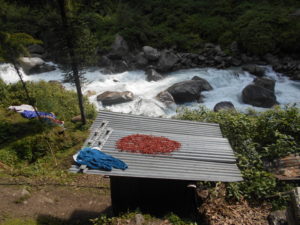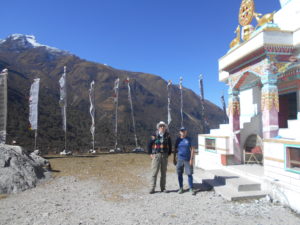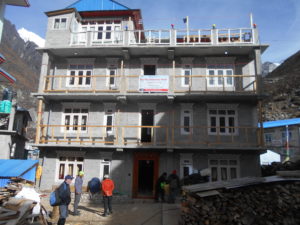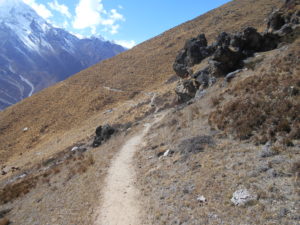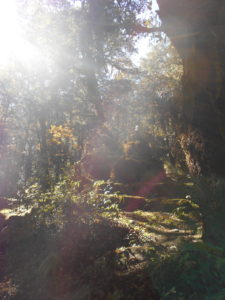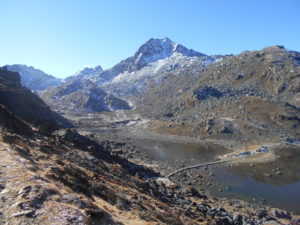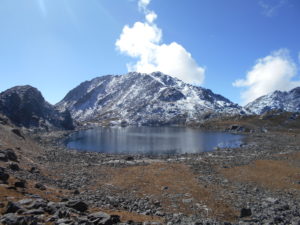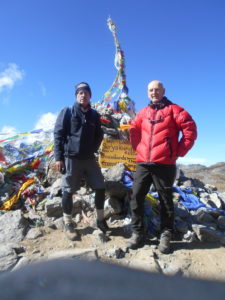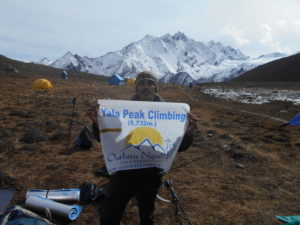I cannot remember how I first found out about Yala Peak in Nepal’s Langtang National Park. At 5,500m, it was high enough to be challenging yet not so high as to be silly; it was off the beaten track away from the swarms of tourists at Everest and Annapurna. Unfortunately, just as Dean (“DC” in previous posts, but he now lives his life in public on Facebook, so Dean it is) and I were about to set off in early 2020, covid hit. Three and a half years on, the time had come.
We arrived on the seventh day of the Nepali festival of Dashain, which meant that Kathmandu was shuttered as everyone was at home. We wandered around for the morning, stumbled across a guidebook on Langtang, which turned out to be very useful indeed.
Our car and driver turned up, along with our guide, Nom, and our porter, Rajan. We had a relaxed and painless drive to the starting point. The chant of the drive became China – not because of the country, but because every time we stopped to look for a tea (chai) shop, it was not (na) open.
We arrived at the Red Panda Hotel, had a decent meal and a comfortable night’s sleep, then set off. We aimed to be at Kyanjin Gonpa on the third night; we arrived before lunch on the third day. Kyanjin Gonpa is a little after Langtang, the town that gives the valley and national park their names. Here are some photos:
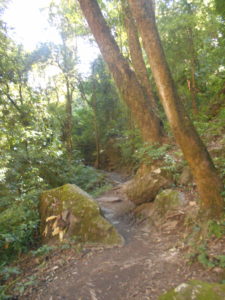

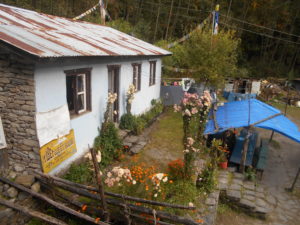
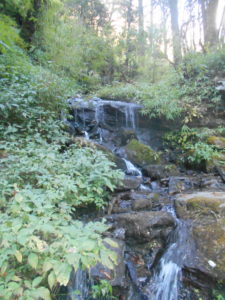
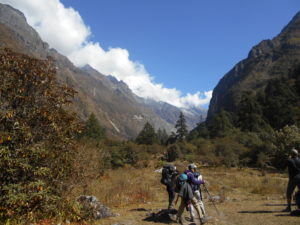

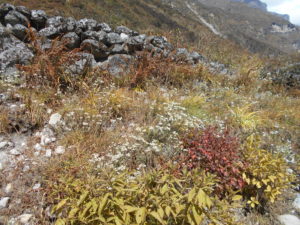

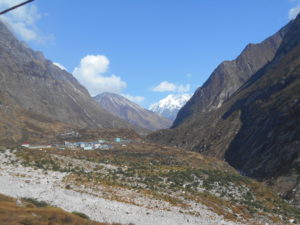
The only encounter of note was on the second day with Wilfred, a former forensic police officer with the Munich police, who has visited Langtang every year for the past decade or so. Local practice is to boil potatoes with the skin on, so he was peeling a load of boiled potatoes by hand prior to having them fried for lunch. He quizzed us on Hong Kong, has been to Japan and Singapore and loves travelling in general, but to Nepal in particular because it is cheap.
Our hotel in Kyanjin Gonpa, The Sunrise Hotel, was friendly and we had an en-suite, which is a luxury in Nepal. After 3000m ascent in three days, the first thing to attend to was washing. We then went in search of a glacial lake that was said to be nearby. I deferred to Dean on the directions, we overshot and got stuck in flurries of snow. There was a ridge to our right and, when we made that, the lake was before us. It was small, and between two natural ridges of moraine. It also powered the micro-hydro that in turn powered the village, supplemented by water and electric solar panels on almost every roof.
The next day we ventured further. I was a little slow, but Dean went leaping ahead and we ended up above the lake, admiring the glaciers of the surrounding massif. My camera was either on on the blink or back in the hotel, so no pictures, but it was beautiful in a rather stark and barren way. That afternoon, we went up Kyanjin-ri, a hill behind the town. I idiotically wore my day-hiking rather than my proper trekking boots. With precipitous drops to one side on a path made slippery by dust from soil erosion, I paid the price. A couple of slips left me rather terrified but unhurt.
At Dorje’s tea house later that afternoon, we got talking to Geet, like Wilfred a regular visitor. Geet is a restaurateur living in Kathmandu, who had carried up his own sourdough and brie (though he didn’t offer us any). “Wow,” he said, when we told him about Yala. He’d gone over the Kyanjin-la pass at 5,300m a few years ago and that was as high as he wanted to go. A thousand meters of scree followed by a night in a very cold tent and a scramble through the snow. No thanks but good luck.
Dean and I looked at each other. The Kyanjin-la was next after Yala.
Back at the hotel, we were the only foreign guests. The others were all Nepalis, who, unable to travel during covid, discovered their own country. Some were inquisitive, some ignored us. The communal dining room was on the top floor of the hotel, and many popped out on to the roof for a smoke – which was only rarely tobacco. Our guide, Nom, turned up, reeking of rakshi, the local hooch. We gave him a smell of Scottish rakshi – the Glen Grant variety – and he wandered off, suitably humbled.
The next day, we set off to Yala Base Camp. This was a long traverse up a hillside:
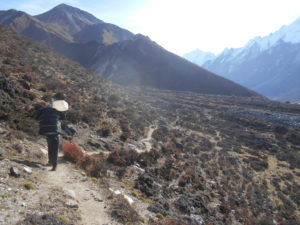
We arrived at about lunch time, and Dean almost immediately assumed attack position:
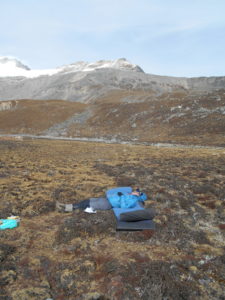
Yala is the mountain behind the man, the rightmost of the ridge.
Dean was doing the right thing. It’s not a criticism but a physiological fact that (perhaps as he’s never been a smoker) he is not used to low-oxygen atmospheres, so adjusts less readily than I. Rest is the best way to get the red blood cell count up, and that is what he was doing.
I wandered around, found out that two other parties were targeting Yala: a large group of Italians and Spaniards who had come up with us, and a lone Frenchman who had already been in the camp for a day to acclimatise. All were heading up in the early hours of the coming morning.
It got cooler, the porters and cook lit a fire from yak dung, I admired the colours of lichen and moss on the rocks, and sunset came and went:
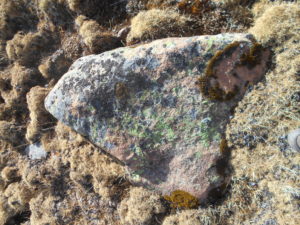
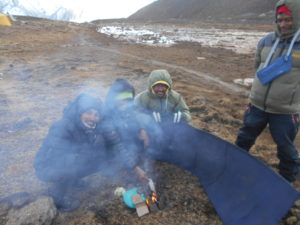
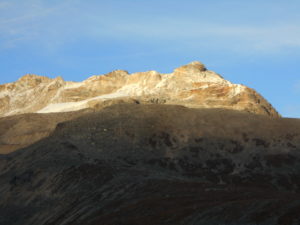


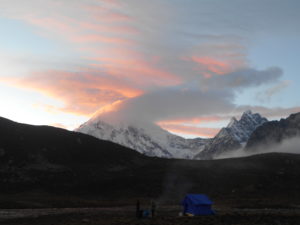
Very quiet, very tranquil, and very beautiful.
It was soon also to become very, very cold. And that was where it all went wrong. I had changed into my long johns and thermal vest, but I did so in our tiny tent and, as a result, a two-minute job took fifteen minutes. I was already cold after that, and my feet refused to warm up. Even poking them in the direction of a yak dung fire did little to help. Dinner, soup, was adequate and I submerged into my sleeping bag. That was okay until the first pee stop, which not only was cold but also saw me pee away a lot of warmth (I’d read about this in an Andy McNab thriller).
The night wore on, my feet got colder and colder and I felt the strength and warmth start to ebb away from my core. I tried vigorous movements and wiggling my toes and fingers, but to no avail. The pressure on my bladder, thanks to the soup, became unbearable. Another venture out into the now frigid night and more warmth pee’d away. Back to the sleeping bag, but something very bad was happening. My entire torso was wracked with micro-shivers. My feet were heading towards numbness. I rearranged myself. No change. Worse. Dean was asleep; I didn’t want to compromise his sleep as he needed to acclimatise. My eyes wanted to shut, but I remembered Shackleton. He’d reached South Georgia from Antarctica and had to march over the island. His men had wanted to rest. “I let them sleep for five minutes and told them it was half an hour,” he said in his book, “because that is a sleep from which no man awakes.” Was I being a drama queen? I staggered out of the tent and to the guide’s and porter’s tent, fifty paces away. By the time I got there I was convulsing uncontrollably with shivers. I hesitated, but there was nothing for it. I yanked open the zip.
Nom surfaced and very quickly realised something was wrong. Five cups of hot water (they had thermos flasks) laced with sugar and I was beginning to feel better. We changed my sleeping bag for one of their thicker ones. I snuggled inside. Within a few minutes my feet were warm, my torso was warm. I fell into an exhausted sleep – only to awake with a bursting bladder. Nothing for it. Outside once more. By the time I got back, although I was not as cold as I had been, I was chilled. I wiggled my feet; they refused to warm up. I wriggled me; I refused to warm up. I was not going to give in. I mentally recited every set piece I know (apart from “To be or not to be,” which would be asking for trouble), every poem I’ve memorised, every song I can sing. Some early hour of the morning came and the Frenchman emerged from his tent, had a cup of something and re-entered it. No sign of the Italians or Spaniards. No sign of the sun, though the moon made the landscape bright. More recitals, dredging my memory. No sun. No warmth in my toes, little in my torso. Another set piece. Was that the first rays of dawn? At last.
Kumar, a porter, woke me up shortly afterwards with a cup of sweet tea. I glugged it, fell asleep for another hour and half and woke up, alive.
It later transpired that that night had seen a sudden drop from a few degrees above freezing to fifteen below. None of the other parties had set off at 3:30 a.m. as planned; the Frenchman was still there, and less than half of the Italians and Spaniards had decided to make the attempt.
(I later found out that although cold feet were the start of it, the peeing had done a lot of damage. The way to deal with this natural urge in extreme cold is to pee into a bottle and take the bottle into your sleeping bag as a hot water bottle. I should have read Andy McNab, ex SAS, in more detail.)
Dean – probably not helped by me writhing besides him – had also had an awful night’s sleep, too. We decided to try a lower mountain, Tsugo-ri, an hour’s walk from our base camp, that morning. That turned out to be a fairly easy stroll and, although neither of us was 100%, worthwhile:
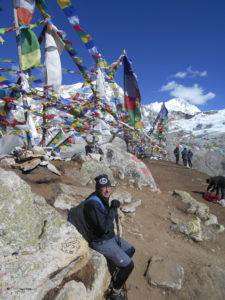
Dean even managed to look somewhat as though he wanted to be there.
Yala, however, was beyond us. Although only another 600m up from base camp, that consisted of 500m of high-altitude scree, followed by a hundred meters of vertical ice and rock. Dean was not properly acclimatised (and, though I didn’t say it at the time, his footwear was not up it) and I was not only exhausted from the cold, but had had my confidence dented in a major way. On top of that, the next couple of days would, according to Geet, see us descend to the valley floor at 4,000m, ascend a thousand meters of scree on the other side of the valley to 5,000m in a north-facing (i.e. no sunlight) bowl, where we would overnight before scrambling up over the Kyanjin-la pass at 5,300m.
And Dean had had enough of desolate places. Beautiful as the base camp was, it was not very different from Ama Damblan, our first exploit a few years ago. And we were surely both too old to be in thin-walled tents at 5,000m and -15°C (which is a lot colder at that height than at ground level).
So we chose to survive. We went a lot of the way back to the road head, turned off and up towards Gosaikund.
This, according to Hindu legend, is where the god Shiva cured a very nasty case of indigestion by stabbing his trident into the earth to bring forth a lake to cool his boiling stomach. The result is a series of glacial lakes. It took another four days to get there:
Those pictures are from our walk on the way down and on the way up again, including a group of monks who, to judge from their language and accents, were from Isaan in northern Thailand; some rather fine stupas; a stuffed yak on The Hotel Yak Nak; and a very sinister but holy hole in the ground on the way to an abandoned and ruined gonpa. We spent a night at The Shittiest Tea House in Nepal where we met a trekker who had gone up the Kyanjin-la pass only to be forced to stop 85m from the top by an avalanche chute of solid black ice. The pass was already closed. We also stayed at the delightful Peace Hotel, where I was taught how to play a dramnyen by the host’s 80-year-old father.
We were now on the part of the route that Nepalis use to go to Gosaikund on weekend dashes, one day up and one day down.Sadly, it shows:
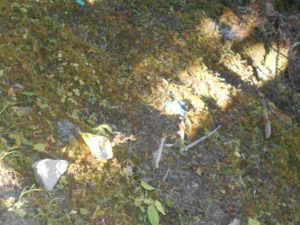
Litter marked the path. We arrived at our next tea house:
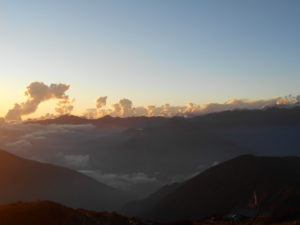
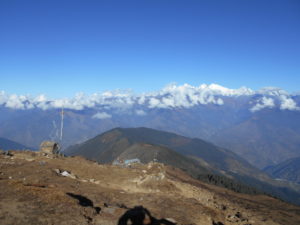
The second taken from an afternoon walk. My night in the cold had left me vulnerable and I was battling a throat infection that the previous day’s over-exertion in finding the abandoned gonpa had done little to help, so I gave up on the afternoon walk and let Dean go on ahead. While I awaited his return, two Nepalis arrived, skinned up a joint (at 4,100m), and offered me a toke. I declined, but not without wondering if they weren’t right, that weed is good for the altitude.
After the walk, the dining room of our hotel contained two Nepalis who were stoned to the point of being very obnoxious, asking questions at the top of their voices, assuming everyone else was in on the joke, playing their own music very loud and smoking inside. We went next door for a beer, by which time they’d been thrown out by the manageress.
There was clattering and banging all night, alarms going off, people coming and going, so I had a dreadful day’s hiking the next day. On arrival at Gosaikund, I collapsed into bed. A couple of hour’s rest left me much better, but it was now snowing outside. Several quick-march tourists, covered in snow, came into the dining room and left. That included a Tibetan who had lost all feeling in his fingers and toes, and who looked very frightened. I had been, too.
By sunset, the snow had stopped:
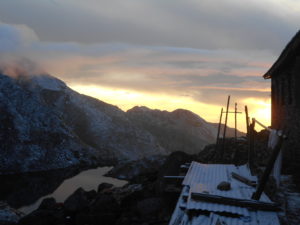
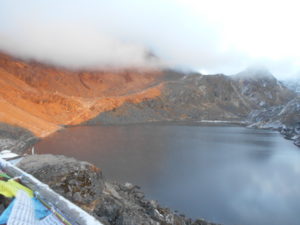
Frigid but stunning. I returned back inside to the communal dining room. A Belgian couple sat next to the stove trying not to shiver, and a group of Czechs came and went.
I was worried that the next day’s hike would be awful, but I cheered up as we went and soon was revelling in Shiva’s destructive creation:
The last few are at the Gosaikund pass, which is the way in from the other side. After that it was, inevitably, all downhill. It took another few days to reach Kathmandu, a lot of that spent in forests and getting used to not being cold. We caught up with or were passed by various of the people we’d met: the Belgians had enjoyed their adventure, though the woman had at one point needed to warm her hands on the belly of a passing sherpa; an Italian and his wife who proudly asked us his age only to respond “seventy-four!”, and a French couple who knew their limits. We had met four doughty Englishmen, including a photographer who disdained equipment and wind farmer. The latter one our first meeting asked Dean about Hong Kong. Perhaps he was expecting an enthused monologue about the hundreds of miles of great hiking, the great beaches and vibrant sporting scene; or perhaps the brilliant operas, plays and performances; or the museums, history and culture, or even just the world-class dining and shopping. What he got was a lecture on the joys of living in a town with no tax and heavy subsidies for old people. We passed the site of a 1992 Thai Airways crash that held particular fascination for Dean (he had to travel a lot for work and flew I think 3 million miles), and we had lunch at a town where a bus full of people arrived from Kathmandu and hit the beer without delay at midday.
Here are a couple more snapshots:
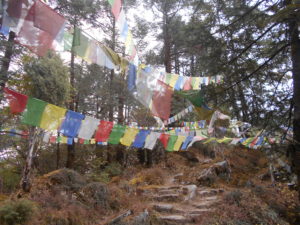
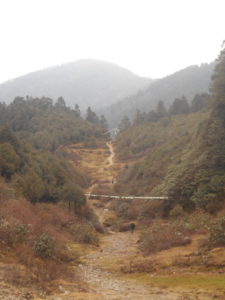
The above two are on the way to Mangin Goth (a goth being a place where herders graze their charges). The next morning we slipped out early in the morning to a deep hoar frost:

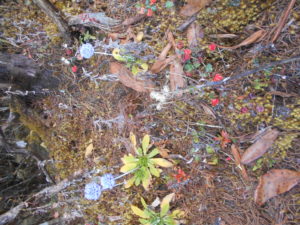
Those hardy flowers seemed to survive being frozen solid. More resilient than me.
Our last night was in Chisopani, at the northern side of Shivapuri National Park, and the site of some devastation from the 2015 earthquake:
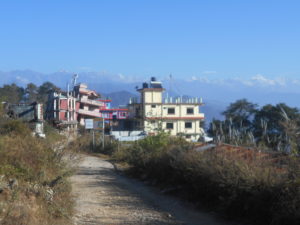
(And, yes, that building with the window and door frames stripped out, but still with a cell tower on top, is leaning over by 15 degrees. We were in the red and blue-painted hotel behind it. As I was on the balcony writing my journal, voices came from another ruin. I never saw who. Spooky.) We met a whole bunch of interesting people. Most were on small hikes from Kathmandu, but one was a lady who had summited Yala a few years before: “a bit technical towards the top” was the best she could say. A fitting end, somehow.
And here, for the record at Yala Base Camp, is Rajan, our porter…
…and Nom, our guide, taking a break half way up a hill. And, yes, that is a beer and a fag in his hands:

